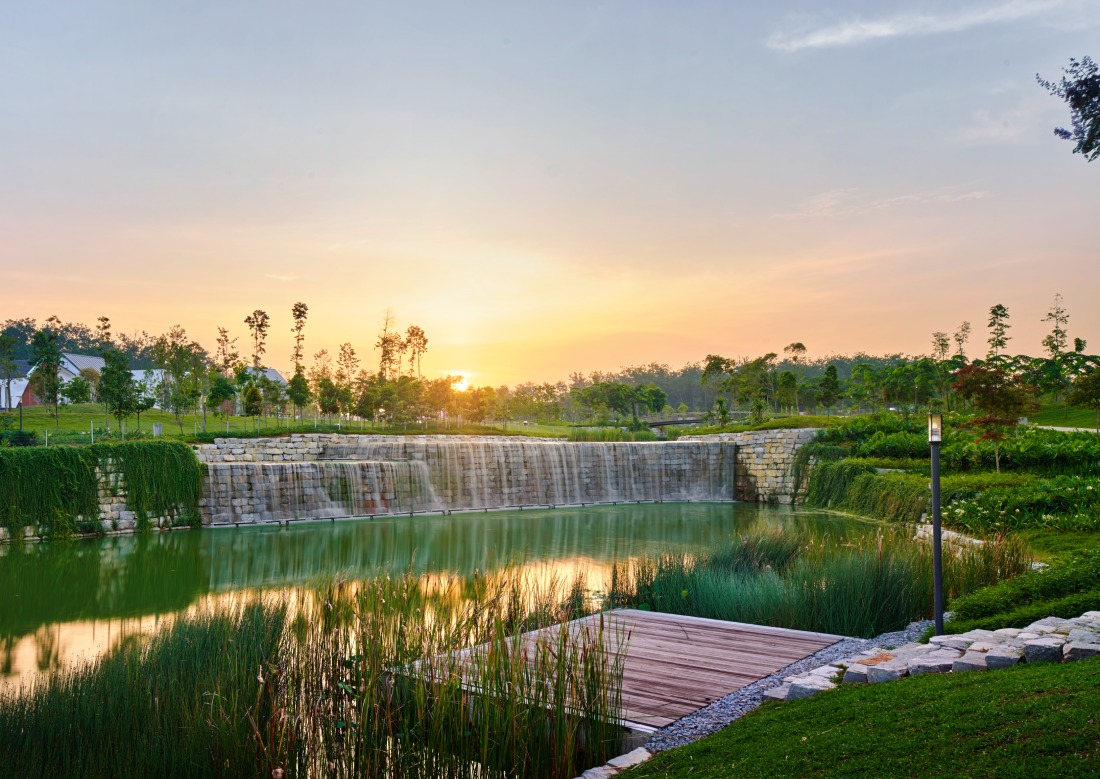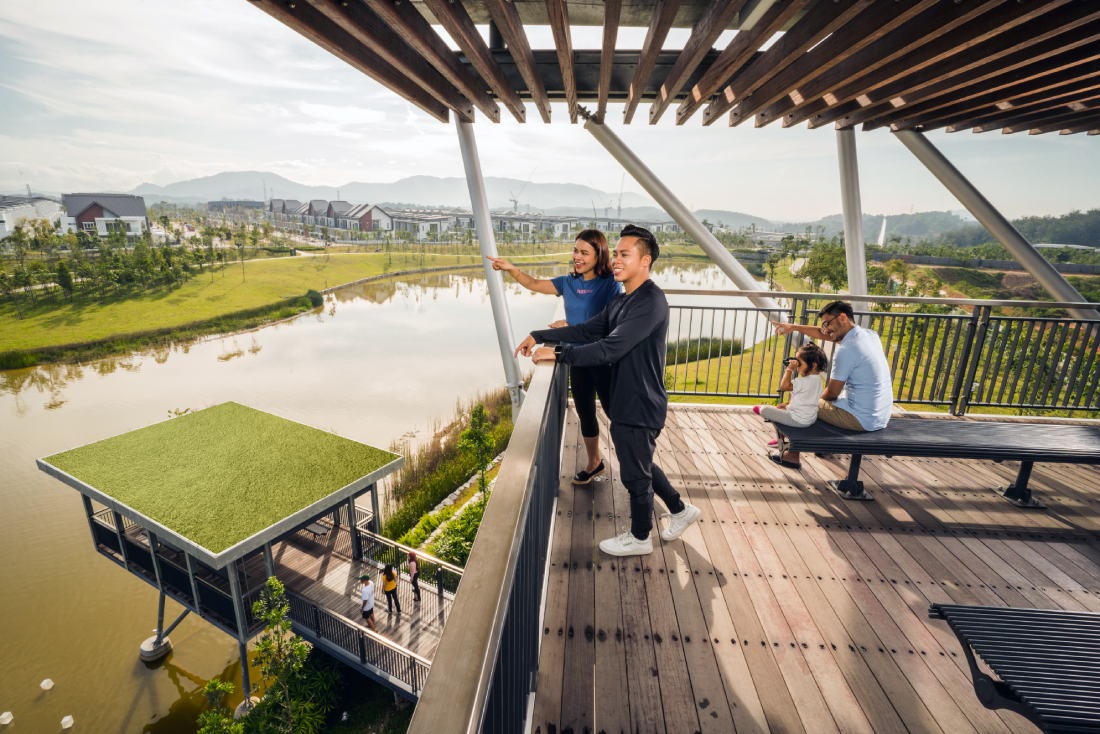Gamuda Gardens: A Biophilic Niche in The Making

It is in our DNA as human beings to have a close relationship with nature. We crave it, we yearn for it and we desire to have a direct connection to it. It was more apparent when in 2020, the world was hit by a deadly virus called COVID-19, that led to a pandemic that eventually had us contained within our closed vicinity in order to stay safe.
For months, we were deprived of social interactions with family, friends, colleagues and even neighbours, leisure outdoor activities including the daily commute to our workplace. We have seen a very abrupt transition in our life. For the lucky few, they still had their home surrounding and immediate yet limited perimeter house gardens. Things were even worse for the unlucky ones including those who lived in big cities, they only had four walls of their home, with no green compound at all. Tim Beatley, a professor of sustainable communities in the Department of Urban and Environmental Planning, School of Architecture at the University of Virginia once said in an interview “We start from the assumption that nature and contact with the natural world are not optional, but (it is) absolutely essential to leading a happy, healthy meaningful life. We need nature close by and around us. It can't just be something we visit once or twice a year, say by visiting a faraway national park”. Professor Beatley who is also the founder and executive director of the Biophilic Cities network.

What are Biophilic Cities?
You might have been wondering the definition of biophilic cities that sound unfamiliar and foreign among the public. These are cities that aspire to be richer in nature within their unique and diverse environments and where the planning and design abundantly incorporate the natural world into the daily lives of the residents. Professor Beatley further describes a biophilic city as “partly defined by the qualities and biodiversity present and designed into urban life, but also the many activities and lifestyle choices and patterns, the many opportunities residents have to learn about and be engaged directly in nature, and the local institutions and commitments expressed, for instance, in local government budgets and policies''. So, in layman’s terms, it refers to having more nature versus the built man made environment and also to encourage human nature interaction. Green infrastructure programmes, parklets, and a high percentage of land cover of green space would be steps towards fulfilling this aspect of a biophilic city
Now you might further ask, is there any locality that holds such a statement in our wonderful country of Malaysia? Although it’s minimal, we can safely say we are moving towards that goal in mind. Gamuda Land, one of few pioneer developers in Malaysia has steadfastly moved towards creating not only sustainable developments in their repertoire but also holistic living communities. According to Dato’ Lin Yun Ling, “As a town maker, we create a place that people will call home, want to be a part of, grow up and grow old in”. It was achieved by listening to the call of the land, or as they term it ‘listening to what the land has to tell us, a philosophy of designing for nature with nature, which was an important aspect in their master planning journey. Gamuda Land endeavours the preservation of land natural features like the hills, rivers, wetlands and forest, while blending it into the neighbourhood thus seamlessly integrating nature with man made creation.
One of Gamuda Land townships adopting this is Gamuda Gardens. Located in Kota Kemuning, Selangor, these 810 acres of land was established in 2017 and managed by an estate management division that started way back in 2001. This estate management division has since grown to even manage properties and township services to seven other Gamuda Land properties all over Malaysia. Gamuda Garden Estate Management specifically was tasked with not only the township day to day running, but also overseeing 3rd party vendors and the service of residents, while providing the peace of mind of an excellent development. With the biodiversity of nature within Gamuda Gardens compound in mind, the estate management team is guided by a policy to ensure minimised impact to the environment and to highlight the best practices required to achieve it.
There is a policy called Gamuda Parks Biodiversity Policy. In August 2019, Gamuda Parks in collaboration of a panel of experts jointly formulated this policy as a guide to governing the conservation of biodiversity and management of the ecosystem through master planning, design development and maintenance of Gamuda Lands developments. The policy championed three ecosystems thrust aptly categorised as Green, Blue and Brown. ‘Green’ indicates Soft Landscape, ‘Blue’ represents Water-scape and ‘Brown’ relates to material and natural resources. Each ecosystem thrust gives attention to diverse related management of trades while applying innovative thinking of other practices to ensure the on-going restoration of the land and biodiversity. This was proven by a Biodiversity Audit that was conducted to check on the progress and condition of Gamuda land development. In 2018, an earlier Sustainable Landscape Initiative was launched by Gamuda Parks bringing forward collaboration with experts of the field, NGO corporations and consultants with the help of host partners, including Forest Research Institute Malaysia (FRIM) on green ecosystem management, Alam Sekitar Malaysia (ASMA) on hydrology as well as several ecologists. Its mandate was to serve as Nature Eco-conscious custodian. This initiative turned into a tangible result that finally became the flavour formula and implementation of the later Gamuda Parks Biodiversity Policy.

Origin of Gamuda Gardens
In the very beginning, Gamuda Gardens, then known as ‘Ladang Satelit’ was originally a rubber estate surrounded by secondary vegetation, industrial and residential settlements. An initial survey and analysis done has identified a host of underlying issues such as improper disposal of biomass that threatens the water quality, generation of soot and dust as the result of open burning and also loss of vegetation and habitat due to excessive land clearance. All of these also inadvertently attracted unwanted pests such as rats, mosquitoes and termites, among others. Being a monoculture plantation estate, the lack of planting varieties affected the contribution and distribution of nutrients to the land. Over utilised plantation activities thus further harmed the essence of the land and were probably the main reason for its abandonment. Scientific study has also shown that plantations of this nature only store 50-90% less carbon compared to a well-diversified forest.
By referring to the land analysis, Gamuda Land then came out with a plot plan based on their master planning philosophy and a comprehensive design strategy with a 5-key element approaches:
- Preserve the main green gully
- Preserve the undulating ground features
- Create natural ponds and waterways
- develop green network to Central Green Park
- Create landed residential parcels.
These approaches see some key design features that do not only enhance the surrounding but at the same time respect the existing language of the land. There is terrain that optimizes home view of residents in each precinct, be it at hilltop, hillside, lakeside or garden living experience. Amidst all of these is the Central Park that becomes a niche, a significant juxtaposition in the heart of Gamuda Gardens. Equipped with the Gamuda Park Biodiversity Policy 3 Ecosystem thrust, it definitely symbolises an achievement.
Gamuda Park Biodiversity Policy and the Three Ecosystem Thrust
The Green Ecosystem Thrust draws aspiration from forest species of a nearby Bukit Lagong Forest Reserve that introduces the planting restoration of 518 trees of Shorea species, 180 trees from the Dipterocarpus species, 98 trees to Cinnamomum species and 46 trees of the Alstonia species to Gamuda Garden’s Central Park. Not to be missed was also the plantation of 120 Hopea subulata (Merawan Kancing) drawn from the nearby Kanching Forest Reserve. The spotlight was to introduce native species that will form a symbiotic relationship between the greens, lakeside, hillside and housing estates. A certain percentage of fruit trees was also introduced to attract birds while creating a safe and habitable environment within the woodland forest of Central Park. To date, out of the 8000 trees planted in Central Park, 77% are native species while 23% are of trees with high conservation importance.
The Blue Ecosystem Thrust aims not only on preserving and making good of water bodies but also enlarging said element while adding ecological resources for wildlife good habitat. Wetlands cells were created to improve water quality while developing self-cleansing lakes. The existing river within Central Park, Sungai Serai was enlarged by 80% to ensure a better flow regime while improving the irrigation system as a whole. The constructed wetland cells, while functioning as biological filters, became an animated functioning wastewater natural treatment thus transforming it to usable natural surface water. The self-sustaining lakes at the Central Park are of different levels and hierarchy to create a cascading effect but also to help mitigate oxidation and stagnant water quality. Provision of the right amount of water at the right time to feed the flora and fauna became an essential tool to the diverse Central Park riverside and wetland system and also the wellbeing of its estates and residential communities. The water bodies do not only serve as a natural cooling agent but as a source of educational and recreational hotspot attraction.
The Brown Ecosystem Thrust deals with biomass disposable activities while spotlighting sustainable value-added lower embodied carbon emission from the solid waste. Implementation of garden waste management does only help to reduce carbon emission but also its maintenance cost such as by not having transporting and waste management. It also acquires its own bio fertilizer from the area itself. Part of Central Park Biomass initial disposable plan has seen about 47,000 tonnes of rubber wood and tree trunks being recycled by the furniture industry and creatively repurposed into eco-friendly designs and products.

Furthermore, Gamuda Gardens went beyond by adopting a series of innovation techniques in other forms to solidify the preservation and enhancement of its environment such as terrain preservation approach by engaging and consulting a renowned golf course designer, Ross Waltson to achieve vantage points. Other techniques that have been implemented are the use of ‘Miyawaki Technique’ on the tree rehabilitation strategy of Central Park to ensure and maximise plant growth, topsoil harvesting and extensive usage of natural resources. The fully restored 50 acres Central Park takes the form of a ‘Restitution Landscape that gives back to nature’, while facilitating and enhancing biodiversity within the township.
Upon all the effort made, Gamuda Gardens has pledged on its annual biodiversity audits, online database in-sync digitised tree tag system and full-proof maintenance, sustainable and cost-efficient township. Their main focus has always been related to people, the thriving nature and the all-encompassing relationship that ties it all and a township that leaves a legacy to the coming generation without having taken anything away.
So, would we bravely call Gamuda Garden Township a biophilic city? Looking at Gamuda Gardens and the herculean effort made, I remember the song lyrics from Louis Armstrong – What a Wonderful World:
I see trees of green
Red roses too
I see them bloom
For me and you
And I think to myself
What a wonderful world
I see skies of blue
And clouds of white
The bright blessed day
The dark sacred night
And I think to myself
What a wonderful world
Indeed, Gamuda Gardens is a township on a mission, wonderfully foraging into direction of becoming a biophilic niche to its community.
LAr. Ainol Najwa Asmuni is a landscape architect by profession, a designer by nature and baker at heart. She joined PTA Design Sdn Bhd back in 2003. With interest in Sustainable Design, one of her projects includes Sunway Rymba Hills that won MLAA 2014, Project of the Year. Venturing now as Principal to E&P Inhabitat Labs, she can be reach via enp.inhabitat@gmail.com or the occasional baking gig at elephantandpeople@icloud.com.

